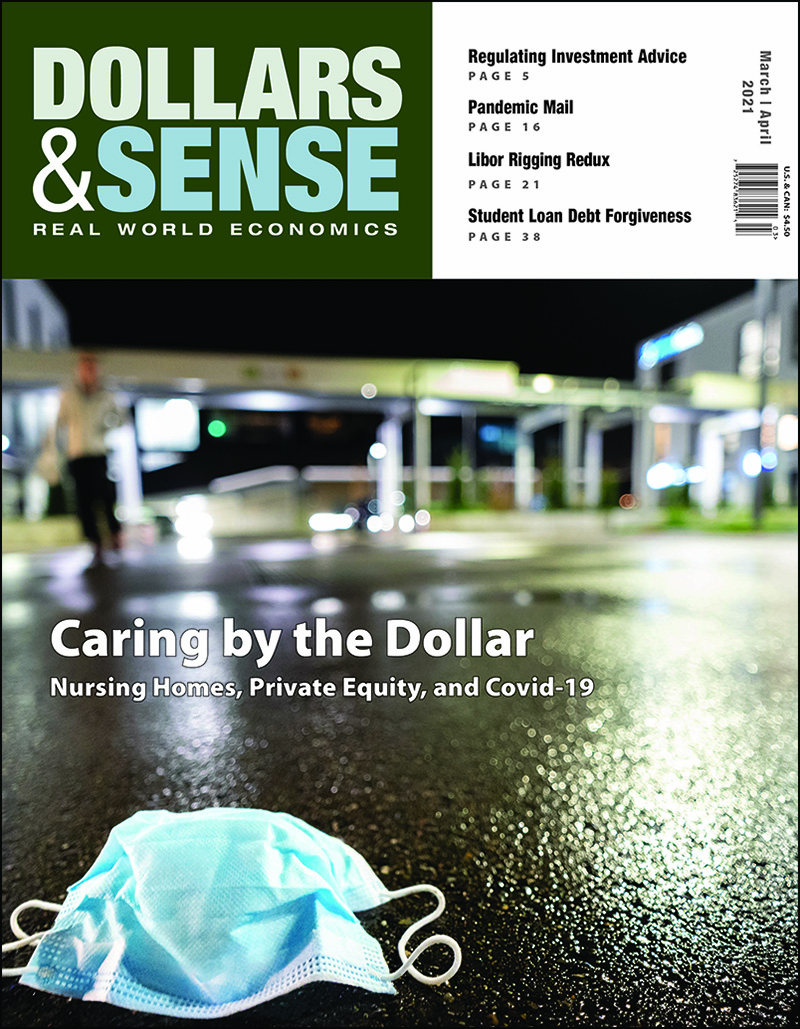Health Insurance for 20 Million is at Risk
If Congress fails to renew the ACA enhanced benefits, millions will be unable to access the health care they need.

Our March/April 2021 issue has gone out to e-subscribers and will be mailed soon to print subscribers. (Not a subscriber? Subscribe online here!)
Here's the p. 2 editors' note:
This issue’s cover story, by economist Bill Barclay, gets at key factors in the nursing home industry that help account for the fact that nursing home residents, who are about 0.5% of the U.S. population, account for some 40% of U.S. Covid-19 deaths. A key culprit: the takeover of the industry by private equity firms, whose business model is the extraction of profit.
Several other articles in this issue address topics that have been in the news lately.
On January 31, one of the only people to be convicted in the Libor-rigging scandal that emerged in 2012, former Citigroup and UBS trader Tom Hayes, was released from prison after serving half his 11-year sentence. With Libor, a key interest-rate benchmark, set to be retired by the end of this year, we might think the scandal has been put to rest. But in his feature article, economist John Summa lays out the evidence that there was a dimension of the Libor scandal that was missed. His analysis strongly suggests that bankers manipulated the benchmark to gain at least $1 billion a year in extra interest.
Another feature in this issue, by historian Christy Pottroff, takes a look at the role that the U.S. Postal Service played in prior pandemics. The postal service is ideally suited to play a key role in public health crises. Yet during the Covid-19 pandemic, the postal service, overburdened and underfunded for years by austerity and sabotage, has been hampered from fulfilling the role it could. Former President Donald Trump’s appointee to head the USPS, Louis DeJoy, carries on in that role under the Biden administration—for now—even as news reports in mid-February tell of how his plans will slow first-class mail and increase rates.
Arthur MacEwan’s “Ask Dr. Dollar” column answers a reader’s question about why there has been a big push to cancel at least some student loan debt. Although President Joe Biden paid lip service to debt forgiveness during his campaign, he recently seemed to balk at the idea, claiming that he doesn’t have the authority to forgive debt up to $50,000 per borrower (although experts have claimed he does), and that it would be unfair to forgive the debt rather than spending that money on early childhood education (but why not do both?).
February is Black History Month, and this issue’s final feature is an interview with economist Ellora Derenoncourt on her research on an important period of Black history in the United States—the Great Migration, when millions of African Americans from the U.S. South relocated to cities in the North, Midwest, and West. Derenoncourt’s “headline” finding is that, while Black migrants sought and found better economic opportunities in the cities they migrated to, their children and grandchildren suffered worse outcomes due to white backlash in those cities.
When northern cities are listed in order by how dramatically their demographics were altered by the Great Migration, Pittsburgh is in the middle of the list, which makes it an important comparison case. So we were thrilled to get permission from the Carnegie Museum of Art to use some of the gorgeous photographs from its Charles “Teenie” Harris Archives to accompany the interview. Harris was a staff photographer for the Pittsburgh Courier, an African-American weekly newspaper whose publication years, 1910 to 1966, coincided almost exactly with the years of the Great Migration. His photos chronicled all aspects of Pittsburgh’s Black community in the mid-20th century; we have selected three photos that show gatherings of multiple generations of Black Pittsburgh residents, whose lives would have been shaped profoundly by the Great Migration. Tens of thousands of photos from the collection can be viewed at the museum’s website (cmoa.org/art/teenie-harris-archive).